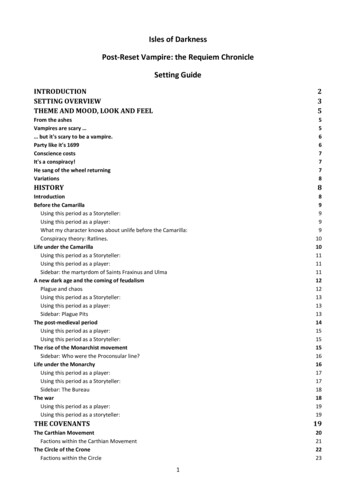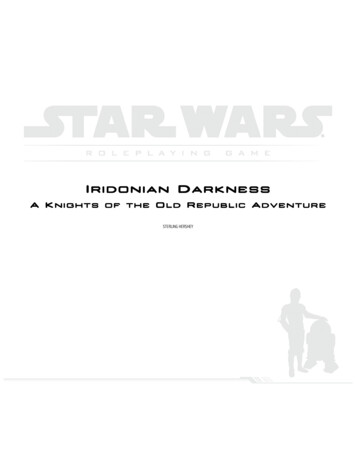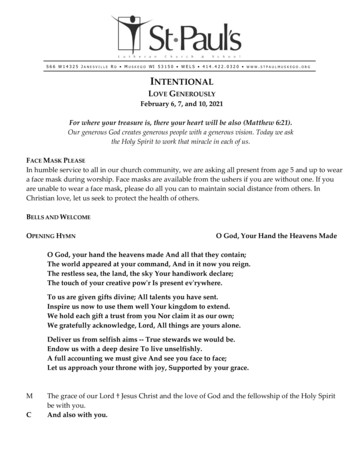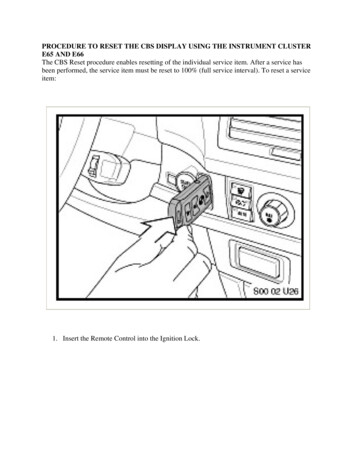
Transcription
Isles of DarknessPost-Reset Vampire: the Requiem ChronicleSetting GuideINTRODUCTIONSETTING OVERVIEWTHEME AND MOOD, LOOK AND FEEL235From the ashesVampires are scary but it's scary to be a vampire.Party like it's 1699Conscience costsIt's a conspiracy!He sang of the wheel ore the CamarillaUsing this period as a Storyteller:Using this period as a player:What my character knows about unlife before the Camarilla:Conspiracy theory: Ratlines.Life under the CamarillaUsing this period as a Storyteller:Using this period as a player:Sidebar: the martyrdom of Saints Fraxinus and UlmaA new dark age and the coming of feudalismPlague and chaosUsing this period as a Storyteller:Using this period as a player:Sidebar: Plague PitsThe post-medieval periodUsing this period as a player:Using this period as a Storyteller:The rise of the Monarchist movementSidebar: Who were the Proconsular line?Life under the MonarchyUsing this period as a player:Using this period as a Storyteller:Sidebar: The BureauThe warUsing this period as a player:Using this period as a storyteller:THE 1818191919The Carthian MovementFactions within the Carthian MovementThe Circle of the CroneFactions within the Circle202122231
The InvictusFactions within the InvictusThe Lancea SanctumFactions within the Lancea SanctumThe Ordo DraculFactions Within the Ordo Dracul242525262728WHO'S WHOANTAGONISTS2828Vampire HuntersThe Order of Saint GuthlacThe Dumuzi ClubBelial's BroodVIIRestorationistsSecond SonsPariahsWild ChildrenThe Sleepless28292930303031313232APPENDIX A32The MonarchsThe Post-Reset Requiem Setting in One PageHistoryAnd NowThe CovenantsAntagonistsThemesYour character3233333333333333IntroductionWelcome to the Isles of Darkness post-reset Requiem setting guide. The purpose of this guide is to give youa glance at the form that the Requiem setting takes in the UK. It is not a comprehensive guide to Requiem –that's in the Requiem books – nor is it a proscriptive guide to how to create the history or setting of yourdomain. What it is, hopefully, is a collection of tools and ideas that will help you create fun, thematiccharacters and conflicts, either as a Storyteller or as a player.There's a lot of history and politics in this guide, but you will notice that there aren't a lot of exact dates. Ingeneral, we've tried to keep things tied loosely to particular periods, both because most social changesoccurs as long-term trends and to ensure maximum flexibility in creating character backgrounds. There arealso a lot of events and locations that aren't specific to a particular place – you'll notice, for instance, thatthe history section describes a Sanctified holy site but doesn't tell you where it is. If, as an ST, you'd like it tobe in your domain, please just contact the GST! We'd like to have the major events of history happen withinPC domains as much as possible.2
If you don't want to read every part of this guide as a player (it is pretty long!), there's an executivesummary at the end. Once you've read that bit, you can read up on the bits that interest you and talk toyour LST about what your character knows about the setting.Setting OverviewThe setting of the post-reset chronicle is a world in turmoil. A recent civil war between vampire factions haseliminated most of their leaders, while the collapse of the country-wide Monarchy has upended many ofthe old certainties.It's hard to identify many country-wide setting elements, but that is itself part of the game's setting. Eachdomain has its own distinct culture, with its own laws, customs, titles and offices. Some of these are so oldno one remembers where they came from, while others are modern creations engineered by Kindreddesperately trying to make their societies work. Each domain therefore has a unique character. In onedomain, court could be a highly formal affair, with titles and precedence firmly established, while inanother it could be an informal backroom meeting of the city's vampire conspiracy. All vampiresunderstand local variation and are accustomed to putting up with it, even if they don't like it personally orcomplain about it afterwards.Each domain around the country is different, but there are certain similarities. No domain in play has beenruled by its current government for more than a few years (although it is possible to make an exception fordomains ruled by NPCs, no ruling PC should be grandfathered in). All domains in play have recently signed apeace agreement that prohibits open war between them. Lastly, all domains in the game share a few basiccultural norms. These are mostly addressed in the history and theme and mood sections, but here are a fewquick summaries in bullet-point form: Social tolerance is important in public.Being an elder gets you some extra respect. Not a lot, but some.Settling scores from the war is not acceptable in public.Escalating a non-violent conflict to violence is the mark of an unstable person.Everyone did things they're not proud of during the war.Taking a political betrayal personally in public is a sign of weakness.Broadly, these norms are supposed to create an atmosphere of conviviality at court, even amongcharacters who loathe each other and are actively working at cross purposes.Note that these are social norms, not iron laws. In some domains, some of these will be more relaxed andothers will be stricter. Some characters will violate these, of course, but players should be aware that this iswhat their characters are doing.3
The disruption that affected all domains has also hit the five Covenants. Old certainties that governed eventhe traditionalist Covenants for centuries have been jarred loose; new factions are emerging, old factionsare returning and no one knows who will be the next great Covenant leaders.Although there is no longer a shared government, history has given most domains a shared cultural legacy.Even domains that were not founded during the Monarchy have some traces of its culture, just as someCamarilla cultural norms are found in Scottish domains that were never part of the Roman Empire. Most ofthese are so simple that the Damned don't really think about them: the recognition of the five Covenants,the importance of the role of Harpy, the shared acceptances of Boons and so on are consistent acrossdomains.Also shared across domains is the Tabula Legis (“table of the law,”) allegedly an ancient Camarilladocument outlining the appropriate punishments for various crimes. Several different versions of theTabula exist, but they share some broad similarities. All domains deviate from it in some ways, and manydomains deviate from it altogether, but its existence is widely known and it's often used as a starting pointon matters of crime and punishment.The actual text of the Tabula is too long to include here, and each Domain's is different, but it'll be availableseparately from this document. The key point is that some crimes appear on more than tablet and that theTabula supports a range of different interpretations. However, these interpretations aren't completelyflexible: no domain thinks that petty theft merits death and no domain thinks that diablerie merits nothingmore than a slap on the wrist.Here are some things that aren't consistent from domain to domain:The title of Prince is common, but it's far from universal. Some Princes are no more than executive officersof a council, while some domains have no single leader at all – although vampires from other domains willoften refer to some particular local strongman as “Prince” anyway. Interestingly, even though manydomains have no Prince, almost all domains do have a Harpy or Harpies.Other titles are even less consistent. One domain's Sheriff is another domain's Marshal or Enforcer or Headof Security, while another domain relies on putting out bounties on malefactors and letting the citizenscollect them.Celebrations and similar public affairs are important in every domain. The exact nature of thesecelebrations varies from domain to domain, but in every domain they fulfil the same vital social function:forcing displays of public social cohesion – or public social conflict – within an established framework.Much of the rest of the world is a mystery to vampires. Even parts of their own domains are shadowy;perhaps they once had infiltrated their human institutions, but the war disrupted their networks ofcontacts. However, this is both a problem and an opportunity – ambitious vampires know that they have achance to take control of valuable resources, both increasing their use to the domain and giving them moreability to strike at their rivals. STs are encouraged to put a good deal of work into making their domain'sinfluence game rich and detailed; we envision this being a significant area for both CvC and CvEcompetition.4
However, the influence game isn't the only challenge facing vampires. See the Antagonists section for moredetail on other threats.Theme and Mood, Look and FeelVampiric society is a secretive conspiracy that exists behind the scenes of our world. In reality, mostconspiracies aren't all that exciting – emails between people who shouldn't be talking, meetings that aren'tabout what they say they're about, conversations over drinks in the same bars everyone else goes to. But inour game, that's not what vampiric society is like at all. The world of vampires is dangerous, sordid andperversely appealing.Partly, that's just the World of Darkness in effect. But it's also just how vampires are; they couldn't help iteven if they wanted to. Even the most modern, pragmatic court is sinister and unsettling, even the mostbrutal and degraded court has a certain cruel glamour about it.This overall look and feel is summarised by a number of themes. Some of the themes pertain to thechronicle as a whole, while others are specific to the first “season” of the game.From the ashesA main theme for the first season is from the ashes. This theme focuses on the struggle of the domains andcharacters to rebuild vampiric society and accumulate much-needed influence in the aftermath of adisastrous civil war. However, playing a society in ruins will only be interesting for so long. After a period ofplay, assuming PCs don't successfully disrupt the recovery, this theme could be retired and replaced withanother, more appropriate one.Other major themes at the beginning of the chronicle will include:Vampires are scary The one thing every Requiem character has in common is vampirism. No matter how kind and civilised, nomatter how reserved and bookish, they all have at least a little bit of the predator in them. When you play avampire character, you're playing someone who is a threat, who views the world with hungry eyes. Yourcharacter, no matter who your character is, is dangerous.We want to bring back the vampire-ness of the game, that swagger that it had before we all got too familiarwith the idea and started to focus more on our characters as investigators or adventurers or occultists orwhat have you. It should be possible to look at any character in the chronicle and see why it was the rightchoice to make that character a vampire – and what “vampire” means to the creator.5
but it's scary to be a vampire.On the other hand, so's every other bloodsucker in the room. Surviving as a vampire means taking risks; itmeans prying into secrets, looking for advantages, building alliances and thinking quickly. There are thingsout there you don't understand, and the things you do understand – humans and other vampires – scarethe shit out of you. And when you think about it, sometimes you think you might be the most frightening ofall.This doesn't mean that the game should be overwhelming, but it should mean that a lot of what vampiresdo is just survive – avoiding detection and ensuring a plentiful food supply. These aren't necessarily plots inthemselves – the game isn't called Herd Manager – but they can certainly be ways in which charactersbecome aware of or become involved in plots.Party like it's 1699New vampires are often surprised by how much time vampires spend partying. You'd think that “court”would be a time for government business, but most of the time it's also this elaborate social display. Don'tthese monsters take anything seriously?The answer is that vampires take celebrating very seriously indeed; hosting courts is an opportunity forthem to outdo one another in wealth, in taste, in who they know, and so on. Government business does getdone at these events, but often informally.Partly the vampiric love of celebration is a form of social competition, and partly it fulfils a psychologicalneed. Vampires, even elders, know that they have to hide themselves, to blend in. To do this, they have toconstantly act – in public, at least – like the humans that most of them consider to be beneath them. Whencourt comes around, therefore, they like to cut loose. The influence of Elders means that vampiric fashionand style is highly anachronistic – but it's a creative, jumbled anachronism rather than simply wearing theclothes of another era. Even the most rigid Invictus blend fashions from different centuries without thinkingabout it.This doesn't mean that all vampires are stylish peacock-types in ruffled shirts or corsets. It does mean thatvampires tend to turn up to court wearing their “colours” – whether that's literal gang colours or a set ofcoded symbols showing House allegiance. A vampire who turns up to court in a t-shirt and jeans is dressinglike an ordinary human – like prey – which is a very bold statement.Vampires tend to be very tolerant of the celebrations of other factions. The Lancea Sanctum might not joinin a Crone rite, but even the most hard-nosed will politely participate in the festivities that surround it. Notto do so would be considered a very grave insult. Similarly, a court invitation that deliberately excluded onefaction would be understood as the prelude to a head-on confrontation.We wanted this theme to reflect the nature of vampire society – a piecemeal thing, created from thecustoms and beliefs of many different eras. But it's also simply one of mood: we wanted to create gameswhich gave a good environment for social competition and display.6
Conscience costsMost vampires don't start out as monsters, even with the prompting of the Beast. They don't kill anddeceive and ruin lives because they like it. It's just easier. Quicker. Safer. And after a while they no longernotice – or, worse, they start to realise they like it.There is heroism in the World of Darkness – it just isn't always easy to see. Vampires are capable, in theirway, of doing good. Some struggle to protect their mortal families, while others try to preserve great worksof art and culture or teach their own knowledge to others. But it's hard. A vampire who wants to do theright thing has to struggle not only against the Beast itself but also against the thousand other factors thatmake ruthlessness a sound choice – not least among them the whole structure of vampiric society. Othervampires might be willing to help you take down a threat that affects them as well without charge – butindulging what they see as your own sentimentality? That's going to cost you, either in boons or in someother way. And the things you might have to do to pay your bills could be unpleasant themselves.It's a conspiracy!A story about a secret society of vampires that exist alongside ours is necessarily a conspiracy story. Thismeans an atmosphere of general suspicion, which is a good thing. But it can also make the gameunwelcoming to new players, who fail to get involved due to the perfectly-justified IC suspicion of existingcharacters.The tone we're hoping for is one of suspicion rather than paranoia. What we mean by this is that it'sperfectly reasonable for vampires to expect that other vampires may try to screw them over, take theirresources, win their allies away from them, outshine them and so on. Everyone understands that this is thenorm, and it's not considered odd for negotiations to proceed from this starting point. Genuinely trustingpartnerships between vampires are rare, and they often end in tragedy.What vampires don't think is that other vampires are trying to screw everyone over. That is – anothervampire might very well be trying to take power, but there's no reason to suppose that she's trying todestroy the domain – or, stranger still, the whole world. The more personal a goal is, the more a vampireneeds to rely only on those he trusts implicitly. But when defending an entire domain, most charactersshould be able to feel that self-interest will motivate locals to help. We want characters to feel wary, butnot at the cost of making it hard for new characters to enter play.He sang of the wheel returningSome historians of the Damned believe that vampire history forms an endless series of cycles of expansionand contraction. Vampire culture flourishes and collapses, flourishes and collapses. Some vampires don'tbelieve in this cycle. Others don't care: the cycle appears to be on the upswing at the moment, and they'regoing to take advantage of the opportunities it offers. Still others prepare for what they perceive as theinevitable collapse. Many of these vampires are in the Invictus and Lancea Sanctum, Covenants that pridethemselves on preserving knowledge and stability in times of crisis. But there are also Acolytes who believethat the crises are tests of strength, and Carthian preppers who stockpile resources against the coming7
apocalypse. But there a few more who think that the most recent collapse shows that the time has come tobreak the cycle, once and for all VariationsObviously, each Domain will have its own themes and moods. These are just some of the overarching onesthat will be expressed in National plot. VSTs can and should emphasise some of these more and others lessin their own games, as well as introducing their own themes.HistoryIntroductionLike everything else in the chronicle, history is a tool for players and storytellers to create stories with. Thepurpose of this guide is not to summarise the whole chronicle history (although there is a document forthat), but to help you understand how to make the history work for you.As we discussed in the introduction, there aren't a lot of specific dates in the history section. For simplicity'ssake, though, here are some dates for the general periods listed here: Arrival of the Camarilla: ca. 100 AD (although later in some areas)Fall of the Camarilla: ca. 430-450 AD (although it clings on in some areas)The Early Middle Ages: ca. 500-1100 ADThe High Middle Ages: ca. 1100-1300 AD. Ish. Establishment of the Invictus in Britain.The Late Middle Ages: ca. 1300-1500 AD. Maybe a little later.Foundation of the Monarchy: ca. 1700, although it's a long process. If you're older than this, youare an Elder.Foundation of the Carthian Movement: ca. 1800, although there had been previous Carthiangroups.Public appearance of the Ordo Dracul: ca. 1880. (CHECK THIS)Assassination of Edvard Haug: 2005.Open war begins: 2006.Ramsgate Massacre: 2010.Beginning of peace talks: 2014War concludes: 2015A complete list of the Monarchs, with the dates of their reigns, is found in the Appendix.8
Before the CamarillaThe only records we have of vampiric life before the Camarilla come from the Camarilla itself, and Rome'sKindred were not much interested in the culture of the “barbarians” they encountered. There does notseem to have been any kind of national culture or organisation, and the few surviving records speak of thepractices of local vampires with a mixture of horror and contempt. Some locals quickly joined the Camarilla,adopting its manner and cultures. Indeed, one of the ruling officials of the British Camarilla is said to havebeen embraced before the arrival of the Romans.Using this period as a Storyteller:Go nuts. Keep the history local – in this era, travel between domains for vampires will have been fairly rare,and even domains quite near each other may have had very different cultures. Remember that thevampires of this era had few of the advantages the Camarilla had – there was no writing, and nopopulations dense enough to sustain large numbers of Damned. Most domains will have been inhabited bysingle coteries or families of vampires.Thematically, this period should be brutal and mysterious. The vampires of this era had almost nothing incommon with their modern heirs, and any plot dating this far back should emphasise the themes ofalienness and mystery. Prehistoric cultures weren't “primitive” – but prehistoric vampires were. Vampiresfrom thousands of years ago should never be relatable.Using this period as a player:The odds of your getting a character approved who dates from this period are infinitesimal. However, if youdo, be sure to coordinate with your LST, who will be able to tell you what your domain was like during thisperiod. Life as a vampire during this time was primitive, without any of the protections of modern society.Food was scarce. Most will remember it as a time of struggle and constant hardship. The fog of ages hasprobably muddled your character's memory to the point whereWhat my character knows about unlife before the Camarilla:Next to nothing. In fact, probably less than nothing, since most of what she knows is probably folklore andhalf-truth.9
Conspiracy theory: Ratlines.A small number of finds suggest organised vampiric activity in Britain prior to the earliest accepted date forthe arrival of the Camarilla. Primarily found in Southern England and in Wales, these artefacts include asmall number of inscriptions and one (unoccupied) Torpor tomb. Three of the inscriptions, including one inthe tomb itself, repeat the same name: Chaluchasu. The language is not Brittonic; it is Etruscan.Some say that the artefacts have been misdated, others that the start date for the Camarilla presence inBritain ought to be moved forward. Still others point out that Romans knew of Britain through trade linkswith Gaul for many years before its conquest. Could another vampiric society have intentionally relocatedto Britain in order to escape Camarilla rulership? No surviving Camarilla texts or inscriptions mention such agroup, but the records are notoriously gap-filled. If there was such a group, it seems to have stayed wellhidden. Given the Camarilla's lax moral code, it's sobering to think what a group of Kindred would have tohave done to be considered outside the pale.Nonetheless, some Damned scholars are eager to find out more about this society. What secrets ofvampiric lore might they have known that were suppressed by the Camarilla?Life under the CamarillaThe Camarilla left few records behind them; we know little of their society other than that it preservedmany mortal Roman cultural traditions and that it was ruled directly from Rome, with the provinces playinga relatively minor role. In Britain, its rule was often tenuous; local elites would have contact with it, butsome groups of vampires continued to survive entirely outside it. Many more were nominally under its rule,but had little direct contact with the government.In terms of sophistication and material culture, vampiric society under the Camarilla reached heights notseen in Britain until the modern day. Several cities boasted elaborate Necropolis complexes, where learneddebates and grotesque blood orgies were equally common. Most of these have since been plundered, butsmaller sites, including the elaborate tombs built by some elders, are still undiscovered. As a rule, shrinesand Necropolis sites have almost always been plundered for their artefacts and documents because theirlocations were public knowledge. However, a small number were maintained by the Lancea Sanctum.Because early Sanctified were martyred in these courts, the faith regards them as holy.What little modern Kindred know about life under the Camarilla suggests that it was a period of peace, ofstrict control over some aspects of unlife and almost total laxity in others. Many regard it as a golden age,when works of philosophy and even poetry were written. Others, however, note that almost every seriouspolicy decision was made from Rome and doubt that modern Kindred would wish to return to that state ofaffairs.Britain's Camarilla presence never equalled that of more settled parts of southern Europe and the NearEast. Even though population density increased during the Roman period, the cities and towns of Britainwere no match in size for cities elsewhere. The vampiric population therefore remained dispersed.Governance was often in the hands of younger childer of Senatorial houses, who would do a tour of a fewdecades in the provinces while being groomed for more important roles later.10
Using this period as a Storyteller:The Camarilla is long gone but it remains a controversial topic among modern Kindred. Think of the waymedieval Europeans saw the Roman Empire – some perceived it as a cruel pagan tyranny, while others sawit as a golden age of art, culture and philosophy. The Camarilla should appear this way in your games (whenit appears at all). Very few (almost no) vampires, PC or NPC, are old enough to remember the Camarilla, butCamarilla art, artefacts and sites still exist; they are highly prized by some vampires.The hunt for knowledge about the Camarilla matters a great deal to these Damned partly because ofacademic curiosity and partly because they believe the Camarilla may have known more about the originsof vampires than their modern descendants. Camarilla artefacts and documents command very high pricesamong collectors, which could motivate some PCs to turn amateur archaeologist (tomb robber is such adirty word). There are even legends of Torpored Elders being sold on the black market, either ransomed totheir own descendants or sacrificed to sate the hunger of closeted Diablerists.Using this period as a player:It is a little more likely that your character will have heard a good deal about the Camarilla, although howmuch of this is accurate is a matter for debate. For many vampires, the Camarilla is more a time of legendthan one of history – less Julius Caesar and more King Arthur. Many of the monarchy's practices werejustified on the grounds of their Camarilla ancestry. Your character is more likely to know the history of hisor her Covenant or bloodline from this era.Sidebar: the martyrdom of Saints Fraxinus and UlmaMany Covenants and coteries maintain the tradition of adopting aliases, whether the revolutionary namesof the Carthians or the code names of the Ordo Dracul. This often results from a period in the group'shistory in which membership was forbidden; members used the aliases not only to conceal theirinvolvement but to protect their bloodlines from reprisals. The oldest such tradition is that of the LanceaSanctum. In the early days of the Faith, Camarilla officials savagely persecuted the new religion. Two of themost famous martyrs in the British Isles were the siblings Fraxinus and Ulma, condemned to death forprotesting blood sacrifices in their home domain in the middle of the second century AD. When the militarygovernor offered to spare Ulma for the sake of her beauty, she disfigured herself with burning coals so thatshe could die along with Fraxinus.Today, the former Camarilla Necropolis where Fraxinus and Ulma were martyred is one of the holiest sitesto the Sanctified of Britain. It has been in continuous use as a Lance basilica since at least the beginning ofthe fifth century, making it possibly the oldest continuously occupied vampiric site in Britain. Over theyears, it has been repaired and modified many times so that almost none of the original complex remains.Yet behind the devotional artwork, shrines to saints and tombs of the faithful, undiscovered Camarillasecrets may remain. Naturally, the Sanctified hierarchy has furiously condemned any attempt to investigate11
the ruins. The conflict between scholars and the faith has been made worse by the fact that many membersof the Circle of the Crone allege that the story of Fraxinus and Ulma is no more than a legend.A new dark age and the coming of feudalismVampiric society is highly dependent on dense human populations. As a result, when the fall of the RomanEmpire and a wave of migration (or invasion) from what is today Germany and Denmark destroyed theurban civilisation of eastern Britain, the Camarilla was wiped out along with its mortal analogue.In the crisis that followed, a curious fact became apparent: in times of peace, elders dominated vampiresociety. But when it fell into crisis, neonates – able to feed on more readily-available food and much moreeasily able to blend in with mortals – tended to survive their more vulnerable masters. History is patchy;individuals and domains sometimes disappear without a trace. Did something happen to them or is it justthat no records have survived?The distinction between the Anglo-Saxon and post-Conquest periods is not important to most vampires,but there were a few differences. Even at the height of Anglo-Saxon England's wealth, very few cities weredensely populated. The mortal government was not quite the feudal model that we tend to associate withthe Middle Ages, and Kindred society remained based more on coteries and families than any other form ofloyalty. Similar models applied in Britain's other nations, where urbanisation was even less common.The post-Conquest period saw not only England but also the rest of Britain more socially influenced byFrance, complete with a more Continental feudal model. The Invictus rose to prominence in this period,and it's easy to see how the experience of the middle ages influenced their thinking. The feudal systemdecentralised control, essential in an age without high-speed communications, and pl
Welcome to the Isles of Darkness post-reset Requiem setting guide. The purpose of this guide is to give you a glance at the form that the Requiem setting takes in the UK. It is not a comprehensive guide to Requiem – that's in the Requiem books – nor is it a proscriptive guide to how to create the history or setting of your domain.










